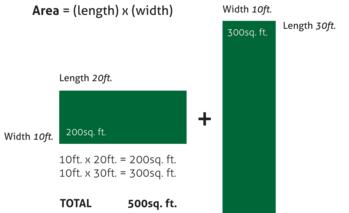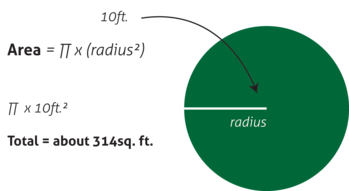Trying to determine how much grass sod, seed or hydroseeding you’ll need for your lawn or landscaping installation? Below we have provided some calculators to help you measure your space so you can decide exactly how much you will need to order.
Measuring Calculators



Installation Instructions
- Till or work the ground to a depth of 4-6 inches. If you have heavy clay soil, apply a soil amendment such as gypsum, peat moss, or compost at the recommended package rates. Soil should be loose and clod free when properly prepared.
- Test the soil with a simple pH soil test kit to check if your soil is acidic or alkaline. If acidic, (a pH of 6 or less) apply a fast acting dolomite lime at the rate of 25 lbs. per 1000 sq. ft. If alkaline, (a pH of 7 or above) apply granular gypsum at the rate of 25 lbs. per sq. ft.
- Fertilize prepared ground with a 16-16-16 or 20-20-20 fertilizer at rate of five to ten pounds per thousand square feet.
- Rake and smooth the soil, removing any large clods, roots or rocks. Level and roll soil for a firm flat surface. Pre-water the ground to prevent fertilizer burn and to aid in creating a firm surface. Allow the ground to dry before beginning to lay sod.
- Start laying sod as soon as possible to prevent grass and grass roots from drying or burning.
- Install sod by laying pieces tightly together in a brick like manner (see illustration). Cover exposed edges of your lawn with soil to prevent the sod from drying out. After all the sod is in place, roll lawn lightly.

- Water new lawn immediately and keep your soil moist for the next two weeks to aid the root system in adapting to its new location. Weather conditions will determine the amount and frequency of watering. During warm weather, consistent water is critical.
- Although your new lawn will look beautiful immediately, you should avoid heavy traffic on the lawn for two weeks. At two weeks, begin to lessen water applications so the lawn can be mowed. Mow at the 2 to 2.5 inch height and bring down to the 1.75 to 2 inch height level for long-term mowing care.
- Mow at 0.25″ – 3″ for Perennial Ryegrass and 2″ – 3″ for Tall Fescue
- Water once a week to help deepen and strengthen root growth. An inch of water is adequate, except in very hot weather when it might need more.
- From March to October, fertilize about every six weeks using a fertilizer with a ratio of 16-16-16. A slow-release winter fertilizer with a low ratio of phosphorus such as 20-4-12 may be used once from late October through early December.
- The first number is nitrogen, important for new and established lawns. Nitrogen makes the grass grow, and helps keep your lawn green.
- The second number is phosphorus, which promotes root growth and development, particularly important in a newly installed or seeded lawn. Once the sod is established, phosphorous is not needed in large amounts.
- The third number is potassium, or potash. Potassium helps with color, drought tolerance and disease resistance without the rate of growth associated with nitrogen.
- Trace amounts of iron will also help with color and a reduction of moss in shaded areas.
